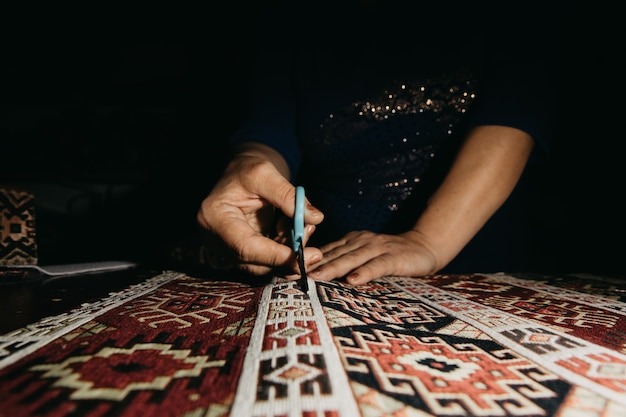Beauty can be present in various kinds. Don’t you agree? Rugs have been exported and imported from many regions, defining and expressing art differently and glorifying the elegance it carries wherever placed. Oriental rugs, famous for their intricate designs and brilliant colors, are cultural artifacts that have endured the test of time.
However, the ravaging effects of time can lessen these artworks’ brilliance, leaving their once-rich colors dimmed. Enter the careful procedure for Oriental rug color correction, which strives to restore the natural richness of these priceless masterpieces.

In this blog, we will look at the accuracy and knowledge of rug color correction and the significance of how it breathes life into discolored rugs while conserving their historical and decorative value.
What is an Oriental Rug?
An oriental rug is a thick cloth made in “Oriental countries” for various pragmatic and metaphorical uses and sold locally and internationally. These rugs can be pattern spun or flat weaved without pattern and made from various fibers, including silk, wool, cotton, jute, and animal hair.
Examples include carrier bags, floor coverings, animal decorations, Islamic prayer rugs, Jewish Torah ark covers, and Christian altar covers ranging in size from pillows to massive, room-sized carpets.
Oriental rugs have been an intrinsic element of their native civilizations, as well as European and, later, North American cultures, since the end of the ninth century.
How Oriental Rugs Are Different From Persian Rugs?
All Persian carpets are classified as oriental rugs. However, not all oriental rugs are Persian rugs. A Persian rug’s bottom pile is equally soft and of the same substance as its upper pile.
Oriental rugs tend to have a foundation material, such as linen or cotton, at the bottom. The bottom pile of a Persian rug is a replica of the top pile. Persian rug edging is neither glued or sewed on. The frills on synthetically made oriental rugs are glued or sewed on with a rigid plastic base.
You have to know the distinctions between the terminology used to describe rugs. Because hand-loomed, handcrafted, and hand-tufted are not synonymous with hand-knotted.
Hand-tufted rugs are manufactured using both handmade and machine-made techniques. This procedure uses A portable machine to insert the design into a blank canvas. Handmade indicates that the fiber is loaded into a machine loom by a human hand, which is a poor imitation of human hands.
Knowing the diffraction pattern and details is crucial to picking the oriental rug color correction and preserving your rugs carefully.
Why Do Color Of Rugs Fade?
Persian, Turkish, and Afghan rugs are weaved with a social custom that spans decades. Exposure to sunshine, foot traffic, and environmental factors might cause their brilliant colors to fade. Oriental rug color correction has become necessary, recognizing the necessity of safeguarding the inherent splendor and historical significance embedded within these fabrics.
How do Artisans Use Oriental Rugs Color Correction to Revive Dull Rugs?
Oriental rug color correction necessitates the expertise of professional artisans. These artists painstakingly dismantle the rug, performing minor alterations while devoting close attention to its initial design. Whether the rug is a historical family relic or a freshly purchased riches, the color correction process necessitates a thorough study of the rug’s materials, framework, and historical significance.
Oriental rug color correction is a delicate balance of creativity and precise science. Expert artisans carefully examine the faded colors, considering the type of dyes used, the rug’s age, and the subtle nuances of hue changes. The problematic method guarantees that the regained colors blend perfectly with the original palette, preserving the rug’s originality and purity.
Besides scientific issues, color restoration is a culturally sensitive practice. The color-correcting technique recognizes the significance of conserving this legacy by incorporating stories, symbols, and traditions into the designs of these rugs. Artisans approach each rug thoroughly, grasping its social and cultural context, guaranteeing that the recreated colors radiate with their original historical and artistic value.
The products used in Oriental rug color correction strike a precise balance between increasing brightness and maintaining resilience. Artists use processes that restore the colors’ richness and preserve the rug’s structural integrity. The repaired rug recovers its previous brilliance and gains life to be loved for years because of the meticulous choice of dyes and materials.
This color correction goes beyond rehabilitation to teach rug buyers the importance of rug care. Rug enthusiasts require assistance to ensure the long lifespan of these cultural treasures by knowing the reasons and right path to revive faded color and implement proper care practices.
Conclusion
Oriental rug color correction is a process to revive the faded colors and revive the fading heritage entrapped in those patterns with the richness of the traditions, bringing warmth, comfort, elegance, texture, and beauty to our homes. The social and cultural blend in art needs attention.
AhmadRug is aware of the different cultures and origins of the color correction region as the team has a mixture of experts from different backgrounds upgrading colors with experienced hands and societal knowledge. Contact us and color your home decor with us!

